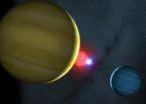The only problem, according to Argentinean researcher Horacio Salva, is that the devices are generally large and unwieldy, making them impractical to install in places where space is at a premium. This limitation was something he and his colleagues at the Centro Atómico Bariloche in Argentina wanted to address.
Now in the American Institute of Physics journal Review of Scientific Instruments, Salva and colleagues report success in what he acknowledges was a fun side project -- building two pendulums precisely enough to make measurements of the spinning Earth yet compact enough to fit in a lobby or classroom of just about any science building.
By definition, Foucault pendulums -- which are named after the French physicist Léon Foucault who first conceived of one in the middle of the 19th century -- count as a simple technology. Generally, a metal orb is suspended by a wire and hung from a height that can be dozens and dozens of feet. The orb is pulled back and released, and as it swings back and forth over the course of a day, it appears to slowly rotate in a circle. In fact what's observed is the Earth moving underneath the pendulum, which swings back and forth in a fixed plane, like a gyroscope.
Or rather, it's more accurate to say that pendulums swing in a mostly fixed plane. That's because, as anyone who pushes a child in a swing can attest, it's tough to keep a pendulum swinging in a straight line. Over time, due to the vagaries of friction and other forces, a pendulum will start to travel in an ellipse, an effect that can easily garble evidence of the Earth's rotation, which for generations has been novel enough to astonish when first observed. Here's the beginning of a February 23, 1908 article in The New York Times describing a Foucault pendulum display in the Big Apple: "Perhaps you were one of the crowd of people who saw the great Foucault pendulum experiment last week at Columbia University. Probably you watched it like the rest with openmouthed wonder."
The heavier the suspended orb and the longer the wire, the more limited the elliptical drift. Similarly, older children on taller swings tend to fly straighter than younger children in the shorter toddler swings.
Consider the dimensions of an 80-year-old Foucault pendulum on display at Philadelphia's Franklin Institute: a 180-pound-orb hangs from a wire 85 feet long and swings back and forth once every 10 seconds. The two pendulums built by Salva are kiddie-sized in comparison. In the case of the first, a 27-pound weight swings back and forth on a 16-foot-long piano wire once every 4 and a half seconds. The second pendulum uses the same weight and an even shorter wire. Using a copper ring underneath each orb to damp down the drift, Salva was able to easily observe and measure precession, the technical name for the movement of the Earth relative to the fixed swinging of the pendulums. Indeed his jiggering of the pendulums was able to tune out all but one percent of the elliptical "noise," at least in the case of his longer pendulum.
Admittedly, says Salva, this new pendulum by no means has the precision necessary to make any groundbreaking new measurements. But the design, he says, is sophisticated enough to be a useful tool for teaching basic physics concepts to physics students and the general public.
"There's obviously no pressure to do work like this," said Salva, who in his day job studies far more sophisticated "pendulums" involving the elasticity of various materials. "It's mostly for fun, though I think it may well help students in the future, too."
Pointing to one possible application, the paper notes that the device was able to detect earthquakes of medium intensity that took place as far away as 765 km. "Some earthquakes can be seen, because the seismic wave moves the support of the pendulum increasing the ellipse of the moment and changing the precession speed," said Salva.
INFORMATION: The article, "A Foucault's pendulum design" by Horacio R. Salva, Rubén E. Benavides, Julio C. Perez, and Diego J. Cuscueta appears in the journal Review of Scientific Instruments. See: http://rsi.aip.org/resource/1/rsinak/v81/i11/p115102_s1
Journalists may request a free PDF of this article by contacting jbardi@aip.org
Audio clip portions of an interview with Dr. Salva are available. For more details, contact: jbardi@aip.org
REVIEW OF SCIENTIFIC INSTRUMENTS
Review of Scientific Instruments, published by the American Institute of Physics, is devoted to scientific instruments, apparatus, and techniques. Its contents include original and review articles on instruments in physics, chemistry, and the life sciences; and sections on new instruments and new materials. One volume is published annually. Conference proceedings are occasionally published and supplied in addition to the Journal's scheduled monthly issues. RSI publishes information on instruments, apparatus, techniques of experimental measurement, and related mathematical analysis. Since the use of instruments is not confined to the physical sciences, the journal welcomes contributions from any of the physical and biological sciences and from related cross-disciplinary areas of science and technology. See: http://rsi.aip.org/
ABOUT AIP
The American Institute of Physics is a federation of 10 physical science societies representing more than 135,000 scientists, engineers, and educators and is one of the world's largest publishers of scientific information in the physical sciences. Offering partnership solutions for scientific societies and for similar organizations in science and engineering, AIP is a leader in the field of electronic publishing of scholarly journals. AIP publishes 12 journals (some of which are the most highly cited in their respective fields), two magazines, including its flagship publication Physics Today; and the AIP Conference Proceedings series. Its online publishing platform Scitation hosts nearly two million articles from more than 185 scholarly journals and other publications of 28 learned society publishers.




